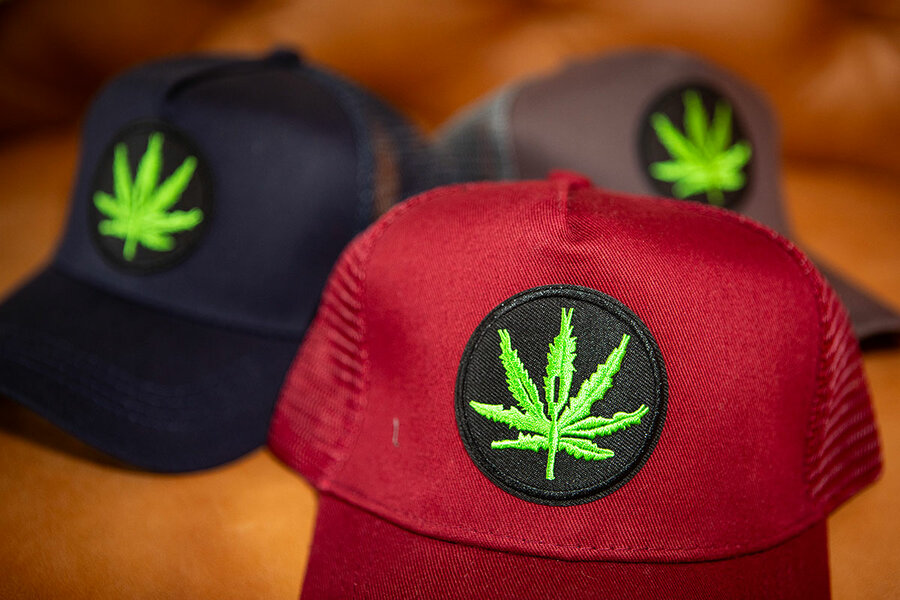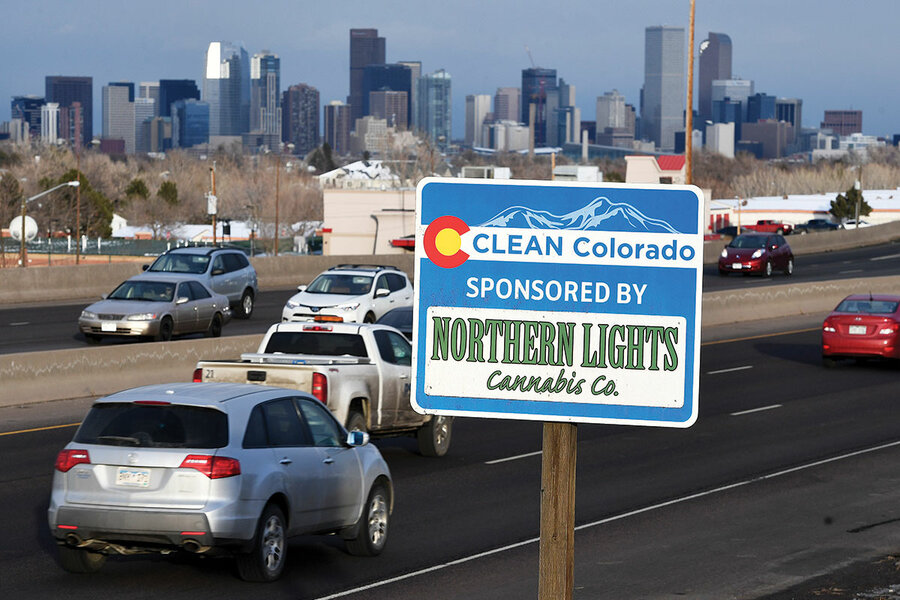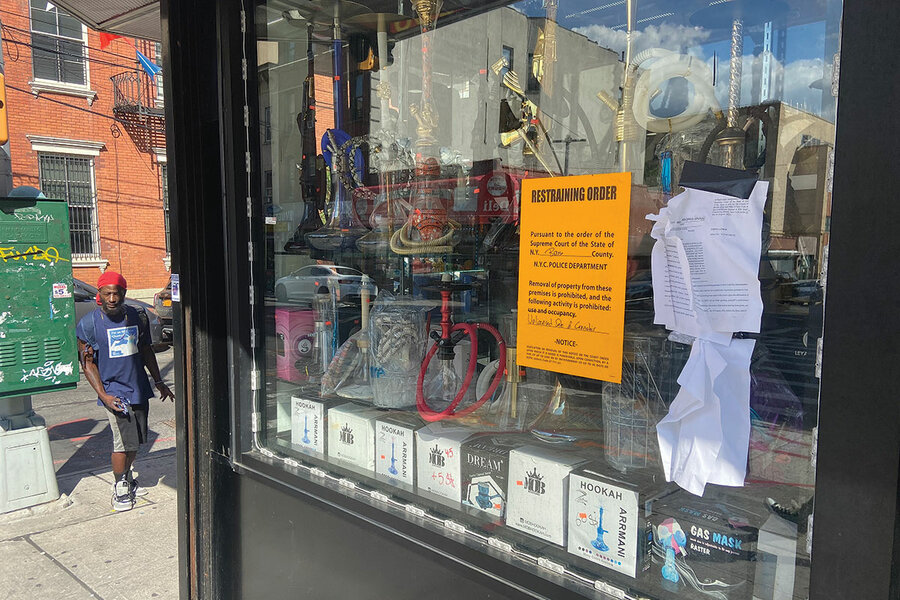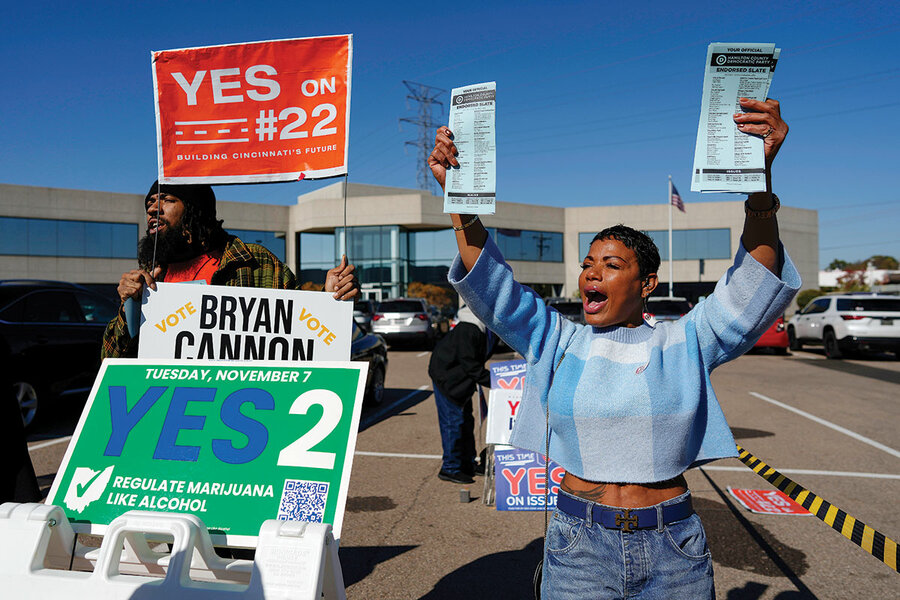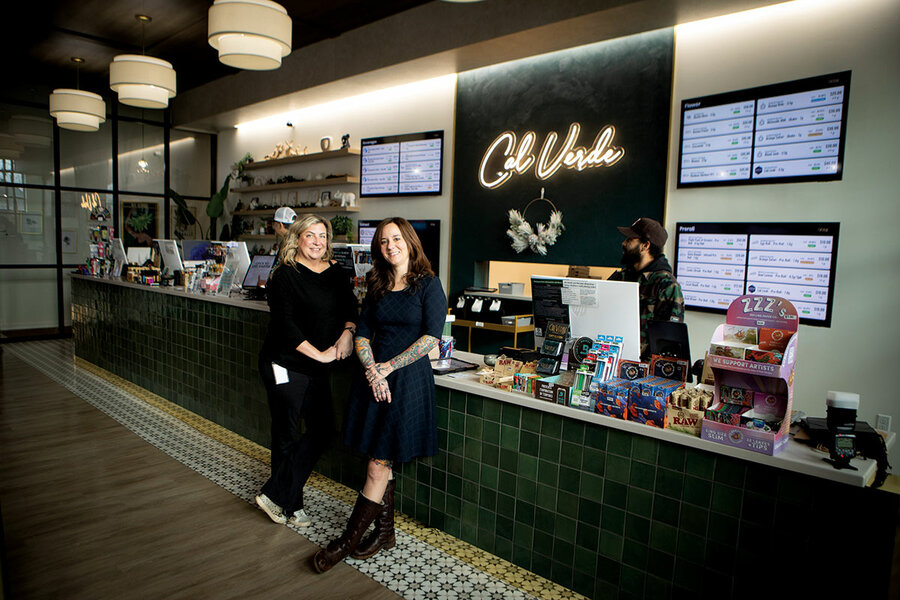Growing like a weed: Taking stock 10 years after legalization began
Loading...
| Denver and Sedgwick, Colo.; and New York and Albany, N.Y.
In Denver, they queued for hours in sleet and snow, waiting to buy pot. It was Jan. 1, 2014, and Colorado had become the first state to legalize recreational marijuana for adults. For the people who waited in line that morning, it was a historic moment to savor.
Ten years on, the whiff of pot is pervasive in parts of Denver. And the stigma of shopping at the dispensaries that dot the streets has largely gone up in smoke, as cannabis takes its place alongside other legal intoxicants.
Why We Wrote This
Ten years after individual states began legalizing marijuana, signs of a shift in perspective surface. Behind the growing commercial presence lie people’s preferences, states’ power – and unanswered questions.
That sense of normalization extends beyond Colorado. More than half of Americans now live in jurisdictions that have legalized recreational cannabis, while 37 states and the District of Columbia provide access to medical marijuana. And a more than $30 billion legal industry has become a significant employer in some states.
Opponents say, among other concerns, that legalization leads to greater cannabis use by adolescents and a deterioration in mental health. Studies have found associations between habitual youth usage and mental illnesses, including schizophrenia and psychosis.
Yet, while a handful of smaller conservative states rejected pro-cannabis ballot measures in 2022, there’s no sign of a wider national rollback. In November 2023, Republican-run Ohio voted to become the 24th state to legalize pot. As Pat Oglesby, who teaches a cannabis policy class at the University of Virginia says, “I think the momentum is for a loosening, not a tightening, of state marijuana sales.”
In Denver, they queued for hours in sleet and snow, waiting to buy pot. It was Jan. 1, 2014, and the unthinkable had happened: Colorado had legalized recreational marijuana for adults, the first state to breach the federal prohibition on nonmedical sales. For the people who waited in line that morning, it was a historic moment to savor.
But that didn’t make Ricardo Baca’s job easy. As The Denver Post’s cannabis editor – another first – Mr. Baca headed out to cover the first day of legal sales, trailed by a film crew shooting a documentary. When customers lined up outside newly licensed cannabis dispensaries saw the cameras, many pulled their sweaters and jackets over their faces to avoid being identified. “People were very uncomfortable going on the record,” says Mr. Baca.
Colorado state regulators had their own concerns about what the United States, including lawmakers in Washington, would see on TV during those first days. Licensed sales were now legal. But smoking pot in public wasn’t, and Coloradans were asked to respect the rules, which nearly all did after making their purchases, says Mr. Baca. “They weren’t lighting up on the streets.”
Why We Wrote This
Ten years after individual states began legalizing marijuana, signs of a shift in perspective surface. Behind the growing commercial presence lie people’s preferences, states’ power – and unanswered questions.
Ten years on, the whiff of pot is pervasive in parts of Denver, though the ban on public consumption remains. The stigma of shopping at the dispensaries that dot the streets has largely gone up in smoke, as cannabis takes its place alongside other legal intoxicants. “More professionals are using it,” says Brian Vicente, a lawyer who co-directed Colorado’s 2012 campaign for legalization via a ballot initiative. “People are not parking three blocks away from their store because they don’t want to have their license plate written down.”
That sense of normalization, of a page turning on an era of pot prohibition, extends beyond Colorado. More than half of Americans now live in jurisdictions that have legalized recreational cannabis, while 37 states and the District of Columbia provide access to medical marijuana, which was pioneered by California in 1996. A more than $30 billion legal industry has become a significant employer in some states; Mr. Baca now runs his own cannabis-focused public relations agency, Grasslands, in Denver.
This wave of state legislation has tracked public opinion on marijuana in a sea change comparable to the shift in approval of same-sex marriage. In 1991, only 17% of Americans favored the legalization of cannabis, according to Pew Research Center. In 2022, 88% of respondents told Pew it should be legal, either for medical and recreational use or for medical use only, while only 10% said it should be illegal.
Illegality is still federal policy: Cannabis is a controlled substance, and producing and trafficking it is a crime. But the Biden administration is reviewing the drug’s classification and has begun pardoning thousands of people convicted by federal courts for simple cannabis possession, citing racial disparities in arrests and prosecutions and the negative impacts of criminal records on offenders’ employment, banking, and housing prospects.
These disproportionate harms on minority communities sparked Mr. Vicente’s initial interest in the issue, he says. “But it did not poll well in Colorado in 2012 for us to talk about the drug war or racial discrimination and marijuana arrests,” he says. “Nobody really cared.”
So the pitch to voters was that legalization would allow Colorado to regulate, inspect, and tax a product that would be safer for adults to consume. A similar ballot initiative also passed in 2012 in the state of Washington, where the legal sale of pot began in July 2014.
Opponents warned that legalization would lead to greater cannabis use by adolescents, higher overall levels of abuse, a deterioration in mental health, and more impaired driving. A decade on, those warnings have continued as studies have found associations between habitual youth usage and mental illnesses, including schizophrenia and psychosis. High-potency concentrates, which have surged in popularity, appear to exacerbate these risks. Critics say these negative impacts are downplayed by politicians who talk up cannabis revenues and jobs.
“On every spreadsheet there’s two sides. We can talk about [tax] revenue all you want. ... But nobody wants to talk about the other side, the health cost and the mental health cost,” says John Jackson, the city manager in Greenwood Village, a wealthy Denver suburb.
Still, beating the drum about the dangers of cannabis can be tough when policymakers are battling an epidemic of overdoses on stronger drugs, primarily fentanyl, that took more than 100,000 lives in 2022. As a drug, cannabis is less deadly than alcohol or tobacco. Tens of millions of Americans already use it, both to get high and to treat anxiety, pain, and depression.
While a handful of smaller conservative states rejected pro-cannabis ballot measures in 2022, there’s no sign of a wider national rollback. In November 2023, Republican-run Ohio voted to become the 24th state to legalize pot. “Nobody has retracted or retreated,” says Pat Oglesby, a tax lawyer who teaches a cannabis policy class at the University of Virginia. “I think the momentum is for a loosening, not a tightening, of state marijuana sales.”
A century after the U.S. gave up on alcohol prohibition as a failed social and economic experiment, it may be edging closer to doing the same with cannabis. But it’s likely to be a zigzag path strewn with potholes.
Behind a papered-over storefront in a small shopping plaza, Christine Richardson pilots a wheelbarrow of discarded wallboard over an uneven floor. Dust floats in the air and clings to her black sweatpants and sneakers and to her bleached blond ponytail. On her way to the dumpster out back, she sways her hips to the Mexican pop music echoing off the bare walls.
When Ms. Richardson looks around the half-built store in Loudonville, a well-heeled suburb of Albany, New York, she pictures how it will look as a cannabis dispensary: wooden cabinets, artful lighting, granite countertops, elegant chairs. “I want it to be more than a pot shop,” she says.
In June she signed an initial lease. A month later, she received her provisional state cannabis license. Then in August she got a call from her landlord: The next-door unit, a former pizza restaurant, was available. Did she want it? She did, so the internal walls were knocked down to create a 4,200-square-foot retail space.
Her plan was to open by Halloween. But New York’s cannabis rollout was put on hold in August by a judge hearing a lawsuit that alleged discrimination in the licensing process, which meant that Ms. Richardson couldn’t open her store, even as the renovation bills kept coming. “Every time I turn around, it’s another 15 ... , 18 ... , $20,000,” she said last fall.
When the New York State Legislature voted in 2021 to legalize recreational pot, many foresaw a financial bonanza, with the state being second only to California in its potential market size. New York’s ambitions went further, though, as Democratic lawmakers in Albany vowed to prioritize social equity in awarding licenses and to invest in communities that had borne the brunt of criminal prohibition.
By doing so, New York joined a wave of blue states like Massachusetts and Illinois that set progressive goals for pot legalization in the form of preferential licensing for businesses run by racial and ethnic minorities, women, disabled veterans, and people with prior cannabis convictions. Some also provide support in raising capital and finding real estate – and even in pot cultivation, which has to be set up in each state, since interstate commerce remains illegal.
In keeping with New York’s preferential approach, Gov. Kathy Hochul had announced in March 2022 a pivot on store licensing: Applicants with past cannabis convictions would go to the front of the line.
Ms. Richardson was all ears. “The minute I found out about the program, I started looking” for retail space, she says.
As a child raised outside Woodstock, New York, in the 1970s, she was surrounded by pot. “I grew up on cannabis farms, not knowing any different,” she says. In 2009, she was arrested at her house, where she had been growing cannabis to sell. Convicted of a felony, she got five years of probation. That led to her losing her nursing license and her house, so she moved to Albany to start over. “You can’t get a job. No one will hire you as a felon,” she says. Eventually she got into real estate management, a career that gave her a leg up in opening a cannabis dispensary.
Once she was allowed to open, that is.
New York pretty quickly became a cautionary tale of political and regulatory missteps that ended up sidelining the very people who were supposed to benefit from progressive policies. “NY cannabis license system broken, say idiots who broke it,” fumed a New York Post editorial in November 2023.
The August lawsuit, filed by four disabled veterans, accused New York of violating its own law in licensing cannabis offenders before other social equity applicants. In late November, the state’s Cannabis Control Board agreed to settle the lawsuit, ending the injunction on approved dispensaries that were ready to open.
By early January, Ms. Richardson was waiting for inspectors to approve her finished store, which she has christened Royale Flower, so that she can open.
But the four-month injunction and previous bureaucratic delays in licensing have stunted New York’s legal cannabis industry: At the start of 2024, some 34 stores were open for in-person sales in a state of 20 million people. And by botching the rollout of legal pot stores, New York left a vacuum to be filled. To the frustration of license holders and anti-pot campaigners alike, well over a thousand smoke shops selling weed without permission have popped up, primarily in New York City.
Most consumers don’t know the difference between a licensed dispensary, whose cannabis products are tested and taxed, and the bootleg stores that have proliferated, says Debra Borchardt, executive editor of Green Market Report, a marijuana industry publication. “They don’t know, or they don’t care,” she says.
Authorities have been slow to crack down on these shops, which also sell tobacco, vapes, and pot paraphernalia. And the state doesn’t necessarily enforce regulations against the advertisement of tobacco and vaping products within 500 feet of a school. In 2022, photojournalism students at the Bronx Documentary Center began mapping the rule-flouting smoke stores in their neighborhoods. Some were only a block or two away from a school gate. “Every corner has a smoke shop,” says Itzel Robles, a student involved in the project.
The students also uncovered stores selling pot to Bronx high schoolers, despite the minimum age of 21 for purchasing marijuana. Educators have complained that more students are getting high before or during school. It’s also harder for teachers to detect the use of vape pens and cannabis edibles – gummies, candies, and drinks – compared with catching students smoking joints.
The reluctance of authorities in New York to strike hard against illicit pot stores is perhaps understandable. After all, the premise of legalization is that the war on cannabis, which began under former President Richard Nixon’s administration, was a misguided policy that was costly to enforce and unjustly executed.
Since legalization, states like Colorado have recorded sharp drops in cannabis-related criminal offenses. But the racial disparity in who is arrested has proven more sticky. Black people are still more than three times as likely to be arrested for possession than white people, who use cannabis at similar rates, according to a 2020 report by the American Civil Liberties Union.
Michael Diaz-Rivera doesn’t know why he was pulled over by police in Colorado Springs in 2006, a stop that led to his arrest and a felony conviction for pot possession. But he suspects that a white teenager caught with weed in the same situation would have gotten away with a caution. “I’m a Black guy. I get pulled over with a car full of Black guys,” he says.
Mr. Diaz-Rivera, who is biracial, did have a reputation, though. He sold weed in high school and acted like a “knucklehead,” he says. The first tattoo he ever got, on his right bicep, reads “Money Mike,” his pot-dealer nickname.
When Colorado began to draft its rulebook for a legal cannabis market, nobody argued that former offenders like Money Mike should be invited to participate in the name of social justice, says Sam Kamin, a law professor at Denver University who served on an implementation task force under then-Gov. John Hickenlooper. “It wasn’t on our radar screen,” he says.
For one thing, Colorado wasn’t sure what the federal government would do when pot went on sale. But it knew that the legal market needed to be kept separate from the illegal trade, so it seemed prudent to license only operators with clean records, says Professor Kamin.
A decade on, Colorado’s cannabis industry is mostly white-owned, to the frustration of Black and Latino entrepreneurs. One challenge is that urban zoning rules make it hard to find a new retail site, which locks in the advantage of existing licensees. New entrants also face a saturated market: Cannabis sales in Colorado have fallen for the last two years.
In an effort to diversify, Denver overhauled its regulations in 2021 to reserve all new cannabis licenses for social equity applicants until 2027. That’s how Mr. Diaz-Rivera became the owner of a delivery company, Better Days, that partners with dispensaries in Denver. “Delivery was just the easiest entry because I didn’t have to have a retail location. I could jump in,” he says.
Social equity programs aren’t a sure bet, given the risk of starting any new business. Mr. Diaz-Rivera’s delivery license was the third issued in Denver; the first two delivery companies have gone out of business. So far, Denver has licensed 32 cannabis firms for social equity applicants, including cultivation and hospitality businesses.
But another justice-related reform holds more promise: expunging past convictions. States like Illinois offer automatic clearance for minor offenses, while others require offenders to petition courts. California has faced criticism, however, for failing to implement its expungement program. A 2021 Rand Corp. study found that racial and ethnic minorities stand to benefit most from these programs, far more than they could expect from preferential cannabis employment policies, given the difficulties faced by former offenders trying to find work, housing, and loans.
Mr. Diaz-Rivera’s state conviction has been sealed, though he’s still on an FBI database. For now, he’s focused on building his business. He has three young children and frets about how much time he’s away on deliveries. As to how he got into the business, and his identity as Money Mike, those aren’t topics he wants to bring up at home.
“If ... ,” he says, then pauses. “When the business is successful and they’ve realized all that I’ve been able to do for the family because of this cannabis business, I’ll be able to talk to them about my story and the felony,” he says.
He still smokes pot. When his children are older, he plans to talk to them about responsible use, reasoning that he can’t counsel abstinence. “But I don’t think I’ll be happy if my kids are smoking in high school. I don’t think I’ll want that,” he says.
Critics say legal cannabis sales to adults leads to greater teenage consumption. But while some studies support this claim, others have found no association between legalization and teen use. A biennial survey by Colorado’s Department of Public Health and Environment of over 100,000 high school students showed little change post-legalization, with around 1 in 5 admitting in 2019 to using marijuana in the past 30 days. This share declined to 13% in 2021 amid pandemic-related school closures, mirroring national survey findings.
What is clear, though, is a steady rise in consumption nationally by young adults over the last decade. A federally funded study in 2021 found that 11% of respondents ages 19-30 reported daily or near-daily use, up from 6% in 2011, while 43% reported use in the last 12 months. Residents in states where recreational cannabis is legal are more likely to consume.
Cannabis isn’t a killer like alcohol, which is responsible in the U.S. for 140,000 deaths a year. Citing the toll of alcohol consumption, advocates of legal pot seek a more moderate view of cannabis use. Society has normalized casual drinking, they argue, while framing pot as a binary choice between abstinence and abuse. “You can be functional under the influence of cannabis,” says Emma Thurston, who manages Cal Verde Naturals, a dispensary in Belmont, Massachusetts.
A former town board member and mother of three, she considers binge drinking in her affluent suburb of Boston a greater hazard than underage pot consumption. “Our role as parents is to talk freely and honestly about what the dangers are” of all intoxicants, she says.
But while alcohol’s risks are well understood, medical experts warn that habitual cannabis use by young people whose brains are still developing affects mental health in ways that researchers are only beginning to uncover. “What we’re worried about is what we call years of productive life lost,” says Sion Kim Harris, co-director of the Center for Adolescent Substance Abuse Research at Boston Children’s Hospital.
A large, long-term study in Denmark found that young men who became dependent on cannabis were at much greater risk of schizophrenia. Researchers estimated that cannabis use disorders among men ages 21-30 may have led to 30% more schizophrenia cases and noted that the proportion had risen in line with higher cannabis potency.
We don’t yet know the full picture for college-age Americans using cannabis today, says Dr. Harris. “It requires more time to see what happens to young people.”
One thing we do know is that pot is more potent today: Concentrations of THC, the primary psychoactive ingredient, average 15%, up from 4% in 1995, according to the National Institute on Drug Abuse. For some cannabis concentrates, which are vaporized or inhaled over high heat, THC levels can exceed 90%.
Ben Cort, who runs an inpatient treatment program in Steamboat Springs, Colorado, for men dealing with addiction and mental illness, has seen an increase in patients with cannabis disorders. He says that high-potency concentrates, which he compares to crack cocaine, represent “the industrialization of a plant” by producers focused on frequent users who are their best customers.
In 2021, Mr. Cort helped organize hearings in Colorado’s Legislature to lobby for a potency cap on cannabis. Lawmakers didn’t take up the proposal, though they enacted legislation to lower daily limits on medical marijuana as a curb on abuse. Other states, including Washington and California, are considering imposing caps on the strength of cannabis.
But the cannabis industry has pushed back. John Moynan, the CEO of Slang Worldwide, a Colorado-based manufacturer of cannabis products, says many consumers use THC levels as a proxy for quality since branding is so new. “The concentrates market does really well because it’s a very potent product” for the price, he says.
Mr. Moynan says regulators should focus on testing and labeling products, not on restricting what is available. “Everybody is able to be a fully informed and safe consumer,” he says.
Another policy tool is taxation. New York and Connecticut levy excise taxes on cannabis that increase with potency, just as liquor is taxed at higher rates than beer. But regulators have also found that high taxes on cannabis, while healthy for state coffers, can make illegal weed more attractive. A combination of high taxes, stringent regulations, and a lack of dispensaries has hamstrung California’s legal recreational market, while illegal producers are thriving.
California faces a law enforcement challenge in shutting down its entrenched illegal industry, says Mr. Oglesby, the tax lawyer, who has advised the state’s regulators. “Cops don’t want to arrest people,” he says. “And juries might not convict them.”
Even where legal pot wins out, states may struggle to regulate a fast-growing industry that, like alcohol and tobacco, makes the bulk of its profits from habitual users and is minded to resist public health measures, such as potency caps. “We don’t have a good model in this country for regulating a habit-forming drug being sold on a commercial basis,” says Professor Kamin.
Some states have mulled a public distribution model, similar to state-run liquor stores, so as to control pricing and availability. But none have put this into practice, instead letting the market lead the way. And that, says Mr. Cort, is a recipe for “Big Cannabis” and its lobbyists to bend policy to its ends and put profit before health, just as Big Tobacco did for decades. “We’re the country that supersizes our Big Macs,” he adds.
From Lupe Casias’ front door on the windblown main street of Sedgwick, Colorado, the town’s three cannabis dispensaries are easy to spot. Their bright colors and signage stand out on a street with limited amenities: a post office, liquor store, hair salon, bar, and town hall, along with Ms. Casias’ bed-and-breakfast in a renovated bank building.
That a sleepy town of 170 people on the plains of northeast Colorado has three pot stores is a function of geography, regulation, and desperation.
Sedgwick is the closest legal cannabis market for several nearby states. On busy days, drivers with out-of-state plates – many from Nebraska, which has no legal recreational or medical marijuana – wait for stores to open at 8 a.m.
After Colorado legalized marijuana in 2014, local communities could decide whether to opt in or opt out. In this rural corner of the state, there were almost no takers. Common arguments are that selling pot leads to an increase in social disorder, traffic fatalities, underage cannabis use, and demand for public health services.
But Sedgwick, a farming town fallen on hard times, was willing to consider the option because its finances were so dire. In 2013, it collected less than $20,000 in taxes. “We couldn’t pay our bills,” says Danny Smith, the current mayor.
So the first dispensary opened in 2015 in a building owned by Ms. Casias. By 2018, the town had annual revenues of $245,000. The next year it decided to issue two more retail licenses, and revenues have since exceeded $1 million.
Thomas Schmittinger, a former Army Ranger, opened his store in 2020 on the site of Sedgwick’s gas station that closed in the 1960s. Before cannabis, “the town was completely dead,” he says. Now the city is investing in water and sewage upgrades, while building its reserves, virtually all paid for by a 5% tax on cannabis sales. New residents are bidding up houses. “People are starting to have some pride in the town,” says Ms. Casias.
Some residents still complain about the pot stores. But a bigger worry is what would happen if Sedgwick had competition for its cannabis dollars, as border towns near New Mexico did after that state legalized pot in 2021. Should Nebraska end its prohibition on legal pot, many of Mr. Schmittinger’s regulars could shop closer to home. “There’s a timetable on this,” he warns. “We only have a short amount of time to make money in Sedgwick.”
Nebraska may not be the deciding factor. In September, the U.S. Senate Banking Committee approved a bipartisan bill to enable federally regulated banks to finance marijuana businesses, a victory for the industry. Some see this as a step toward eventually allowing interstate commerce, which would lead to consolidation across the industry and make border dispensaries dispensable.
But it’s also possible, say analysts, that cannabis follows the path of alcohol after federal prohibition ended in 1933, with state and local laws creating a patchwork of wet and dry counties that continues to this day. Mississippi was the last state to end prohibition – in 1966.
And just as legalizing pot doesn’t mean an end to illegal pot, the legacy of alcohol prohibition lingers. “They’re still making moonshine in Kentucky, and that’s after 90 years,” says Robert Solomon, co-chair of the Center for the Study of Cannabis at the University of California, Irvine.
For now, the availability of recreational cannabis is up to states and to local communities like Sedgwick. Tax revenues there have trended lower since 2021, but the town has plenty in the bank, and the visitors keep arriving for a taste of legal weed. “As long as we can milk the cows, we’re going to do it,” says Ms. Casias.




